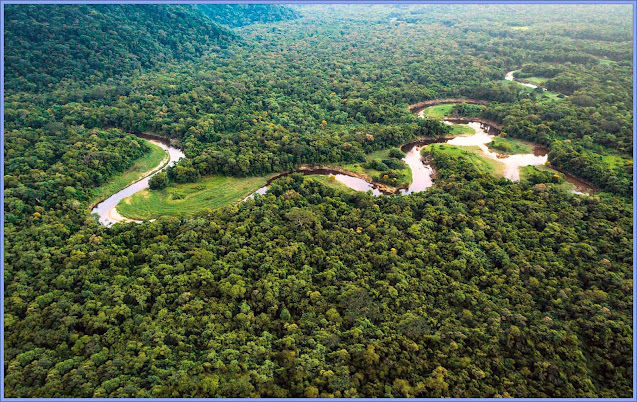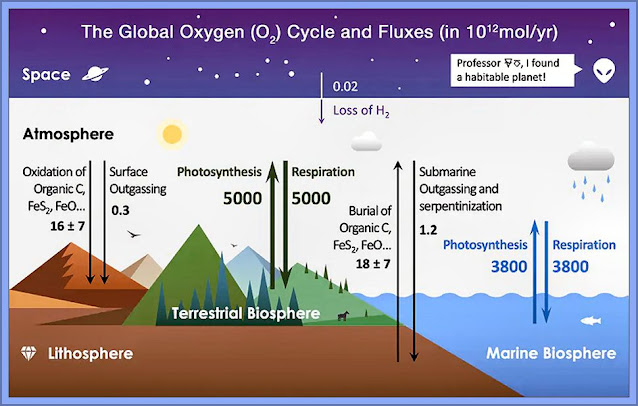The Tropical rainforest’s are often said to produces 20 per cent of the world’s oxygen.
This has often given them the sobriquet as the“Lungs of the Earth”.
However this is actually very wrong .... because the maths simply don't add up. This fact has been supported by a number of scientists, such as Earth systems scientist Michael Coe, who directs the Amazon programme at the Woods Hole Research Centre in Massachusetts, USA, who have pointed out that in fact, the Amazon’s net contribution to the oxygen we breathe, is likely to be around zero.
They have calculated that there simply isn’t enough carbon dioxide held in the atmosphere, for the number of trees to photosynthesise an entire fifth of the planet’s oxygen from their leaves. Its a simple equation, which you can do on the back of an envelope - for each carbon dioxide molecule trees pull out of the atmosphere, they can only push an equal number of oxygen molecules back into the atmosphere. Now as the atmosphere contains less than half a percent of carbon dioxide, but around 21 percent oxygen, it’s simply not mathematically possible for the Amazon and other forests to generate that much oxygen.
An ecosystem ecologist at Oxford University’s Environmental Change Institute, Yadvinder Malhi, has calculated (in figures generally accepted as accurate), that in actual fact, the tropical forests are responsible for more like 34 per cent of the photosynthesis occurring on land. So based on its size, the Amazon would account for about half of that, at about 16 per cent of the oxygen produced on land .... the term 'on land' is the clue to where the rest of the worlds oxygen is created .... yes the oceans. Phytoplankton (plankton and algae), to be precise, and if you take this into account, the Amazon produces about 9 per cent of the worlds Oxygen production.
It gets even more complicated, when you realise that during the night, when there’s no sun around for photosynthesis, the trees all become net absorbers of oxygen, in a process known as cellular respiration. Its how they continue to grow at night, as they convert all the sugars they have amassed during the day, into growth energy, using oxygen to power the process. Research suggests that trees actually inhale a little over half the oxygen they have produced in this manner - so the Lungs of the Earth may be producing less that half the net oxygen
And in the final nail in that coffin ... the remainder of their net oxygen output is very likely used up by the countless microbes that live in the Amazon, which inhale oxygen to in order to break down the dead organic matter of the forest for consumption. This all means that the net oxygen effect of the Amazon (or any other biome such as the African rainforest), is around zero for the planet.
So how are we keeping the oxygen levels we breath?
There are four main reservoirs of oxygen on Earth: the terrestrial biosphere (green), marine biosphere (blue), lithosphere (Earth’s crust, brown), and atmosphere (grey). Coloured arrows show fluxes between these reservoirs. Burial of organic material causes a net increase in atmospheric oxygen, and reactions with minerals in rocks cause a net decrease.
Simply put, its down to the legacy of all the phytoplankton in the oceans and in the rocks under our feet, that over billions of years steadily accumulated the oxygen that made the atmosphere breathable. Because when they died they became trapped in the ocean sediment, before they could rot, and the oxygen wasn't used by other microbes during their decomposition. For oxygen to accumulate in the air, some of the organic matter that plants and phytoplankton produce through photosynthesis must be removed from circulation before it can be consumed, because that consumption by microbes uses up oxygen, thus cancelling the amount of oxygen that the algae had produced at the surface as it grew.
This process can only happen because in the sterile depths of the worlds oceans microbes can't live ...... this fragile fluke, that microbes can't live below a certain depth in the sea, is what allowed Phytoplankton to sink into the sediment without being consumed. thus leaving a net oxygen contribution and levels to rise to the current 20 per cent that sustains us and the other creatures of the planet.
Our existence hangs on some very slim flukes ....
 |
| Lungs Of The Earth? |
This has often given them the sobriquet as the“Lungs of the Earth”.
However this is actually very wrong .... because the maths simply don't add up. This fact has been supported by a number of scientists, such as Earth systems scientist Michael Coe, who directs the Amazon programme at the Woods Hole Research Centre in Massachusetts, USA, who have pointed out that in fact, the Amazon’s net contribution to the oxygen we breathe, is likely to be around zero.
They have calculated that there simply isn’t enough carbon dioxide held in the atmosphere, for the number of trees to photosynthesise an entire fifth of the planet’s oxygen from their leaves. Its a simple equation, which you can do on the back of an envelope - for each carbon dioxide molecule trees pull out of the atmosphere, they can only push an equal number of oxygen molecules back into the atmosphere. Now as the atmosphere contains less than half a percent of carbon dioxide, but around 21 percent oxygen, it’s simply not mathematically possible for the Amazon and other forests to generate that much oxygen.
An ecosystem ecologist at Oxford University’s Environmental Change Institute, Yadvinder Malhi, has calculated (in figures generally accepted as accurate), that in actual fact, the tropical forests are responsible for more like 34 per cent of the photosynthesis occurring on land. So based on its size, the Amazon would account for about half of that, at about 16 per cent of the oxygen produced on land .... the term 'on land' is the clue to where the rest of the worlds oxygen is created .... yes the oceans. Phytoplankton (plankton and algae), to be precise, and if you take this into account, the Amazon produces about 9 per cent of the worlds Oxygen production.
It gets even more complicated, when you realise that during the night, when there’s no sun around for photosynthesis, the trees all become net absorbers of oxygen, in a process known as cellular respiration. Its how they continue to grow at night, as they convert all the sugars they have amassed during the day, into growth energy, using oxygen to power the process. Research suggests that trees actually inhale a little over half the oxygen they have produced in this manner - so the Lungs of the Earth may be producing less that half the net oxygen
And in the final nail in that coffin ... the remainder of their net oxygen output is very likely used up by the countless microbes that live in the Amazon, which inhale oxygen to in order to break down the dead organic matter of the forest for consumption. This all means that the net oxygen effect of the Amazon (or any other biome such as the African rainforest), is around zero for the planet.
So how are we keeping the oxygen levels we breath?
 |
| Oxygen Levels Earth Are Governed By The Lithosphere And Dead Phytoplankton From Old And Current Oceans. |
There are four main reservoirs of oxygen on Earth: the terrestrial biosphere (green), marine biosphere (blue), lithosphere (Earth’s crust, brown), and atmosphere (grey). Coloured arrows show fluxes between these reservoirs. Burial of organic material causes a net increase in atmospheric oxygen, and reactions with minerals in rocks cause a net decrease.
Simply put, its down to the legacy of all the phytoplankton in the oceans and in the rocks under our feet, that over billions of years steadily accumulated the oxygen that made the atmosphere breathable. Because when they died they became trapped in the ocean sediment, before they could rot, and the oxygen wasn't used by other microbes during their decomposition. For oxygen to accumulate in the air, some of the organic matter that plants and phytoplankton produce through photosynthesis must be removed from circulation before it can be consumed, because that consumption by microbes uses up oxygen, thus cancelling the amount of oxygen that the algae had produced at the surface as it grew.
This process can only happen because in the sterile depths of the worlds oceans microbes can't live ...... this fragile fluke, that microbes can't live below a certain depth in the sea, is what allowed Phytoplankton to sink into the sediment without being consumed. thus leaving a net oxygen contribution and levels to rise to the current 20 per cent that sustains us and the other creatures of the planet.
Our existence hangs on some very slim flukes ....








No comments:
Post a Comment
All comments are welcomed, or even just thanks if you enjoyed the post. But please make any comment relevant to the post it appears under. Off topic comments will be blocked or removed.
Moderation is on for older posts to stop spamming and comments that are off topic or inappropriate from being posted .... comments are reviewed within 48 hours. I don't block normal comments that are on topic and not inappropriate. Vexatious comments that may cause upset to other commentators, or that are attempting to espouse a particular wider political view, are reviewed before acceptance. But a certain amount of debate around a post topic is accepted, as long as it remains generally on topic and is not an attempt to become sounding board for some other cause.
Final decision on all comments is held by the blog author and is final.
Comments are always monitored for bad or abusive language, and or illegal statements i.e. overtly racist or sexist content. Spam is not tolerated and is removed.
Commentaires ne sont surveillés que pour le mauvais ou abusif langue ou déclarations illégales ie contenu ouvertement raciste ou sexiste. Spam ne est pas toléré et est éliminé.